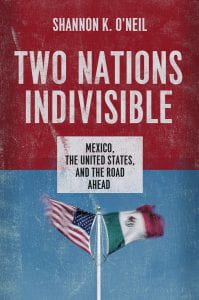A Review of Two Nations Indivisible: Mexico, the United States, and the Road Ahead
Mexico’s Great Transformation and U.S.-Mexican Relations

Two Nations Indivisible: Mexico, the United States, and the Road Ahead By Shannon O’Neil (New York: Oxford University Press, 2013)
As graduate students in Harvard’s Department of Government, Shannon O’Neil and I read from the same interminable Mexico reading list handed to us by our mentor, Professor Jorge Domínguez. A few years later, in 2002, we became good friends in Mexico City. Alejandro Poiré, a fellow Domínguez student, was then Chair of the Political Science Department at the Autonomous Technological Institute of Mexico (ITAM), where I was a faculty member. He provided Shannon with an office during her Fulbright stint, and so ITAM fast became an ongoing seminar for a gringa and this Mexican-American pocho to learn about Mexico’s great transformation from our chilango colleagues and friends, often over lunch and sometimes in their smoke-filled offices.
Now a Senior Fellow for Latin American Studies at the Council on Foreign Relations, Shannon O’Neil has written an outstanding book on U.S.-Mexican relations, Two Nations Indivisible. At present this is the best book to hand to anyone eager to learn about contemporary relations between the two countries. It is also an excellent complement to in-depth scholarly examinations of Mexico’s political and economic transformation, such as Haber and others, Mexico Since 1980 (2008, Cambridge University Press) and Hamilton, Mexico: Political, Social and Economic Evolution (2010, Oxford University Press).
In cheerful and vivid prose, Two Nations Indivisible describes and explains how the two countries have become tightly integrated in the last two and a half decades as a consequence of globalization, a closeness manifested in booming immigration, trade, and investment flows. O’Neil analyzes Mexico’s astonishing political and economic transformation, its implications for the United States, and what the United States can do to help its neighbor prosper. It is an inveterately optimistic and forward-looking book about two nations that may often have kept a distance from one another but now find themselves in a marriage of convenience.
In addition to its nuanced portrait of Mexican-American interdependence, Two Nations Indivisible provides a compelling narrative of Mexico’s transition to democracy and efforts to reform the state to achieve a more dynamic and less crisis-prone economy, one that can continue to grow the middle class, reduce poverty, and generate more consistent and faster growth. The author provides a trenchant analysis of how Mexico is attempting to untie several Gordian knots in key policy areas such as security, education, economic regulation, and criminal justice. The book also gives valuable advice for policymakers on both sides of the border for leveraging the benefits of integration.
Two Nations Indivisible, however, is not naïvely optimistic. O’Neil’s vision of Mexico’s future is rooted in a scholar’s understanding of democratization and the challenges of reforming state institutions in a political environment where powerful vested interests—labor unions, corrupt politicos and bureaucrats, monopolists, and, let it be said, narco-traffickers—fight tooth and nail with reformers to block progress at every opportunity. Mexico’s electoral system stacks the deck against citizens in favor of political parties and special interest groups through policies such as the prohibition of reelection, the lavish funding of political parties, and fiscal transfers to states with limited electoral accountability. Political parties too often cut deals to protect their respective vested allies.
O’Neil, though, does not get lost in this gloomy forest when she considers the road ahead. After all, Mexico has emerged in relatively good shape from an economic lost decade and a half between the financial crises of 1982 and 1995. It is easy to underestimate the significance of this accomplishment and to forget that economic stability was finally achieved after democratization took root in 1998, when the “official” political party lost control of congress for the first time.
Two Nations Indivisible points out that Mexico today has a sizable and growing middle class that boasts higher levels of education and consumption as well as smaller families. Though poverty levels remain unacceptably high, progress in reducing these rates has been real. The country continues on a trajectory of steady and modest economic growth thanks to economic openness and macroeconomic stabilization. Mexico joined the General Agreement on Tariffs and Trade in 1987 and the North American Free Trade Agreement in 1993. It threw its doors open to foreign direct investment after decades of protection and heavy regulation. An independent central bank and successive governments since the mid 1990s have managed monetary and fiscal policies prudently, so much so in fact that there is room for fiscal expansion to invest more aggressively in education, poverty reduction, and state-building.
The Mexican government and congress, however, need to agree on extracting more badly needed revenues from a woefully under-taxed society that boasts some of the lowest levels in the OECD. O’Neil reminds us that policymakers need to open the internal market to domestic competition, efforts that are resisted fiercely by modern Mexican robber barons that have cartelized markets and pay too few taxes. The government also needs to inject competition in key labor markets—such as education—where unions continue to reign supreme.
Two Nations Indivisible blends unflinching political economy analysis with some good old fashioned faith in democratization, markets and civil society, all of which have taken root in Mexico since the early 1980s. Its accounts of the challenges in specific policy areas such as immigration reform or security cooperation with respect to U.S.-Mexican relations, and anti-trust, policing, or judicial reforms with respect to Mexico, do risk leaving the reader in despair. It is sometimes difficult to reconcile the grave challenges with the book’s cheerful optimism. Yet O’Neil bets that its vibrant civil society will, in the decades ahead, defeat many of the troglodytic forces in Mexican politics. I too am betting that Mexican political institutions will continue to evolve and adapt to the rapid social changes and demand for reforms.
Two Nations Indivisible argues throughout that the United States needs to do more to improve the bilateral relationship. It notes, though, that the September 11, 2001, attacks derailed U.S.-Mexican relations for nearly a decade while the United States waged its global war on terror. At the same time, diplomacy has been less prickly since the early 1990s, particularly in the wake of NAFTA, the financial bailout of 1995, and security cooperation under the Merida Initiative. Mexican anti-gringo nationalism thawed considerably, perhaps in part because many high officials have lived and gone to school in the United States and most citizens have a friend or relative living up north. It is hard to reject the proposition that U.S.-Mexican relations have never been better.
Today the most urgent and immediate policy challenge for the bilateral relationship, not to mention the fate of several million de facto Mexican-Americans and their children, is immigration reform. As a former undocumented child of immigrant parents, I found this analysis particularly enlightened. The Obama administration’s unprecedented and disgraceful deportation policies have been a cruel and needless blow to Mexican-American families on both sides of the border. O’Neil dispels many misconceptions that pass for knowledge about immigration’s economic and social challenges. Immigration flows north have now slowed to a trickle as a function of demographics, the costs of crossing the border, and a growing Mexican economy. Still, U.S. policymakers focus their energy on deportations, walls, and border patrolling rather than other badly needed improvements.
The book argues that getting policy towards Mexico right is the most pressing and important U.S. foreign policy priority. The potential implications of China’s economic slowdown, the European banking and currency fiascos, the Middle East turmoil, and the Korean Peninsula remind us that this is debatable. Mexico’s real achievements underscore that the risk stemming from Mexican political and economic instability has been mitigated significantly. It is not clear what the U.S. government can or should do to support Mexican progress beyond requested technical and material assistance to aid with state capacity-building efforts, such as the Merida Initiative. The Mexican Congress and the executive would have to agree on broad outlines of a strategy for more ambitious initiatives, and these would have to be coordinated at the state and local level across party lines. This level of coordination on Mexico, except perhaps in extremis, is not in the cards in the short run and perhaps never will be.
O’Neil correctly notes that Mexico will do most of the heavy lifting with respect to state-building tasks. Perhaps the best that the United States can do, given domestic political constraints in both countries, is to work quietly with the Mexican government and states as opportunities manifest themselves. These two large and unwieldy federal democracies will continue to tackle challenges piecemeal and in an ad hoc manner. Each contains powerful nativist political forces that welcome walls. The main message of Two Nations Indivisible is that the great transformation in Mexico and U.S.-Mexican relations can be prodded constructively along if policymakers and citizens become more aware of the opportunities for deeper integration.
Gabriel Aguilera is Assistant Professor of International Security Studies at the Air War College, Maxwell Air Force Base, Montgomery, Alabama. He holds a PhD from the Harvard Government Department. His research focuses primarily on Latin America and international political economy. The views expressed here belong solely to the author and do not necessarily reflect the official policy of the U.S. Government, Department of Defense, or the Air War College. He can be reached at Gabriel.Aguilera@us.af.mil.
Related Articles
A Search for Justice
In 2004, when I left Harvard and last saw you, I thought I would never learn the truth of what exactly happened to Carlos Horacio in the horrendous holocaust of the Palace of Justice in Bogotá. Yet fate was holding a tremendous surprise for my daughters and me, filled with…
Memory: Editor’s Letter
Editor's Letter Memory Irma Flaquer’s image as a 22-year-old Guatemalan reporter stares from the pages of a 1960 Time magazine, her eyes blackened by a government mob that didn’t like her feisty stance. She never gave up, fighting with her pen against the long...
A Search for Justice in El Salvador: One Legacy of Ignacio Martín-Baró
In the small rural town of Arcatao, Chalatenango, Rosa Rivera clung to the hope that one day she would find the remains of her disappeared mother and father and lay them to rest in peace. Others sought to exhume mass graves hoping to recover bodies of nearly 1,000 relatives massacred in the Río Sumpul. …




